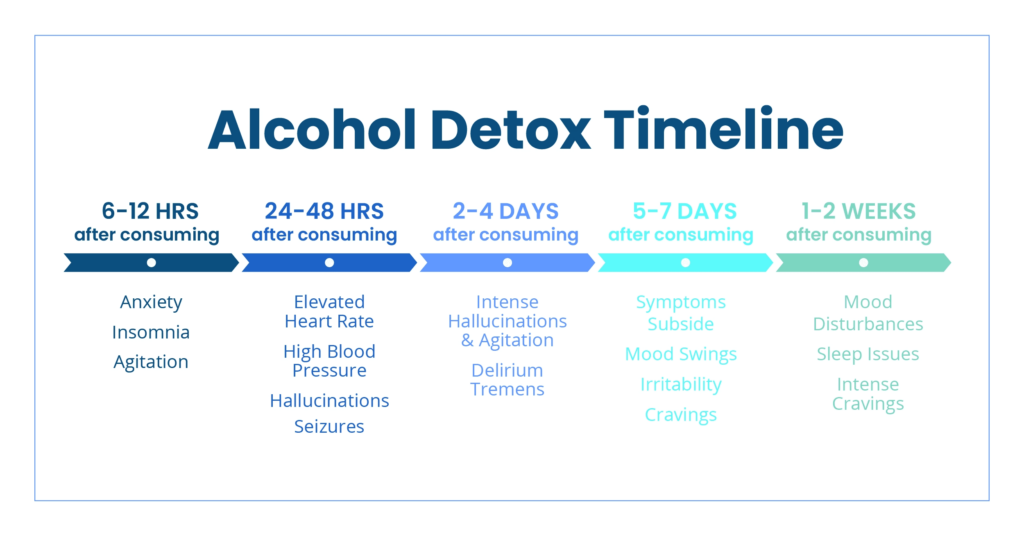According to the National Center for Drug Abuse Statistics, 140,557 people die from alcohol in the United States each year. In addition, 1-in-10 Americans over age 12 have an alcohol addiction and need treatment. Those who realize they have a problem often attempt to go “cold turkey,” that is, stop drinking suddenly and without professional help. Most experience mild to severe symptoms of alcohol withdrawal. In the most severe cases, symptoms are life-threatening.
Recognizing the symptoms of alcohol withdrawal can help you determine when you or someone close to you is in withdrawal and when to seek help. Treatment options are available during the detox period and provide the individual with effective follow-up care and resources to support continued recovery.
Alcohol Withdrawal Syndrome (AWS) Defined
Heavy drinking for months or even years creates a host of physical and mental challenges. Should an individual stop drinking suddenly, they will experience side effects ranging from mild to severe. Alcohol is a depressant that slows the brain’s function. Over time, the nervous system adapts to as much of the alcohol intake as it can by working harder to keep the brain active and the nerves functioning. This is what many people think of as “tolerance.”
However, when the drinking suddenly stops, the nervous system continues as it has been and thus remains in an elevated state. This creates the symptoms we know as withdrawal. Prolonged alcohol use changes brain activity, so suddenly removing alcohol from the body produces neurological and physical reactions.
Alcohol withdrawal syndrome is a group of various symptoms that present when someone dependent upon alcohol either stops drinking or abruptly reduces their alcohol intake. The sudden change triggers physical reactions. When a person stops drinking, their brain activity is disrupted, which leads to many withdrawal symptoms that begin within hours of the last drink.
While the range and severity of symptoms vary with each person, at least 80% of those with an alcohol dependency will experience withdrawal symptoms. A person’s body chemistry, age, other contributing health conditions, and the amount of alcohol consumed daily are all factors in the number and severity of withdrawal symptoms they may experience.
Detox treatment assists people through withdrawal and prepares them for further treatment.
Stages, Severity, and Types of Alcohol Withdrawal Symptoms
The severity of alcohol withdrawal depends on the level of physiological alcohol dependence. According to The American Academy of Family Physicians, there are three stages of withdrawal that an individual may experience.
Stage 1: Mild Symptoms
Mild symptoms begin within six to eight hours of the last drink; however, they may not appear until days later. Most symptoms peak within the first three days, although some can linger for a week or more.
Stage 1 symptoms may include any of the following:
- Anxiety, nervousness, or depression
- Clammy skin
- Fatigue
- Gastrointestinal upset
- Gray complexion
- Headache
- Hand tremors
- Heart palpitations
- Insomnia
- Loss of appetite
- Mood changes/irritability
- Nausea/vomiting
- Nightmares
- Rapid heart rate
- Sweating
Stage 2: Moderate Symptoms
Stage 2 symptoms may include any of the above listed for stage 1 as well as the following:
- Confusion
- Increased blood pressure or heart rate/heart palpitations
- Mild hyperthermia (excessive body temperature)
- Rapid abnormal breathing
Stage 3: Severe Symptoms
The most dangerous side effect of alcohol withdrawal is delirium tremens, which many refer to as the “DTs.” It is also called alcohol withdrawal delirium. Delirium tremens often occur when a heavy drinker stops drinking cold turkey.
Severe symptoms can also occur if the person has suffered a head injury or has a serious infection. Symptoms may begin as early as 48 to 96 hours after the last drink. However, they may not appear until ten days after the last drink.
A person suffering from delirium tremens may show signs of neurological or mental changes. These may include severe confusion, changes in mental abilities, deep sleep (sleeping for a day or more), hallucinations, and sensitivity to touch, light, and sound.
In addition to delirium, other severe symptoms include any stage 2 symptoms plus the following:
- Chest pain
- Disorientation
- Fever
- Auditory or visual hallucinations
- Impaired attention
- Seizures
- Stomach issues
Anyone suffering from severe symptoms should receive medical attention immediately. While the more dangerous conditions that can emerge with alcohol withdrawal are rare, they do occur. Some predictors of severe alcohol withdrawal, like seizures, include the following:
- Abnormal liver function
- Being of an older age
- Brain lesions
- Comorbid illnesses
- Dehydration
- Electrolyte disturbances
- Heavy daily alcohol use
- History of DTs
Treatment Options
If you think you are experiencing alcohol withdrawal symptoms, see a doctor if at all possible. Seeking medical treatment is wise because moderate to severe alcohol withdrawal can be dangerous, sometimes even life-threatening. Your doctor will ask questions about your drinking history and when you stopped drinking. They may even ask if you’ve gone through withdrawal before. To be thorough, they may also rule out any medical conditions that may be causing or contributing to your symptoms. From there, you can ask questions and discuss treatment options. If you attempt to detox without medical treatment, you may progress from stage 2 to stage 3 quickly.
Average Timeline for Withdrawal
The timeline for alcohol withdrawal varies based on factors like the degree of heavy drinking behavior, other mental and physical health issues, etc. However, a typical timeline for alcohol detox is as follows:
- From 6 to 12 hours after the last drink: Mild symptoms of early withdrawal begin, including mild anxiety, headache, insomnia, slight tremors, and upset stomach.
- Within 24 hours: Possible visual, auditory, or tactile hallucinations.
- 24-72 hours: Some symptoms may have peaked and begun to resolve. Some symptoms may stick around for weeks or longer. Seizure risks are highest from 24-48 hours after the last drink. Withdrawal delirium tremens may appear from 48 to 72 hours after the last drink.
Some people experience more persistent symptoms like sleep disturbances, fatigue, and mood swings that last for months. Understand, however, that most people recover with proper medical assistance.
Seeking Medical Treatment for Alcohol Detox
Medical detox is often the recommended first stage of treatment. Medical assistance helps you through the alcohol withdrawal process. However, it doesn’t address the underlying causes of alcohol addiction. Following the withdrawal period, the individual should seek ongoing treatment and support to maintain sobriety after detox.
The alcohol withdrawal process is highly variable and unpredictable. Physicians often use screening and other assessment tools to help, though it’s impossible to be sure who will experience severe symptoms. Individuals who experience moderate to severe symptoms or those who may be at risk for severe symptoms benefit from inpatient monitoring and treatment.
Inpatient or residential treatment involves checking into a facility for around-the-clock care, support, and therapy throughout detox treatment. Outpatient treatment is available for those experiencing mild-to-moderate symptoms of alcohol withdrawal.
Outpatient treatment means living at home or in a sober living environment through the detox process, though you are required to attend regular group and individual therapy sessions. The added therapy sessions enable you to manage stressors while navigating real-world situations.
Why You Should Not Detox at Home
As a person progresses through alcohol withdrawal, mild symptoms can progress to more severe symptoms. Intense withdrawal symptoms may emerge twelve to 24 hours after the last drink. Here, hallucinations and seizures can manifest. Hallucinations can be terrifying, as they appear very real to the person experiencing them. Delirium tremens or DTs may soon follow. Such symptoms trigger other physical issues, including heart failure, that can become fatal.
Anyone who attempts to complete alcohol detox alone or without medical assistance is risking complications. There is no way to predict how a person will experience withdrawal. Doctors involved with the alcohol detox program often use prescription medications to decrease the severity of symptoms and lessen the chance of complications due to severe withdrawal. Such medications include benzodiazepines such as clonazepam (Klonopin), lorazepam (Ativan), diazepam (Valium), and alprazolam (Xanax). They calm the body, prevent seizures, lower the heart rate, and diminish tremors and muscle spasms.
Other medications may also be prescribed to help stabilize patients or provide supportive care. Examples are antipsychotics, anticonvulsants, alpha-adrenergic agonists, and beta-blockers. Supplements may also be given to restore any mineral or vitamin depletion.
Detoxing at home means no access to these beneficial medications and supplements, which means no protection against possible complications.
In addition to withdrawal, the person detoxing may also be dealing with mental illness, depression, PTSD, or anxiety. Alcohol may have been a way to self-medicate in response to these issues. Once drinking stops, withdrawal symptoms as well as mental health symptoms may emerge at once, bombarding the person with more than they are prepared to handle, physically and emotionally.
For all the reasons discussed above, detoxing at home can be dangerous; thus, it is not recommended.
Post-Detox Programs for Ongoing Recovery
Detox treatment programs are intended to be a healthy starting point for a substance use treatment program. Maintaining sobriety is a lifelong journey, and detox is merely the beginning. Once detox is complete, moving on to a structured treatment program should be the next phase. Rehab programs provide therapy, reduce stressors, and address family or relationship issues. Treatment programs also reduce the likelihood of relapse. Whatever treatment follows detox depends on the individual’s needs and preferences. However, everyone should take some fairly common steps once they complete a detox program.
Follow-up Care
Follow-up care helps individuals maintain sobriety and break the habits that lead to alcohol dependency. Such care can include a combination of professional addiction treatment, family therapy, and cognitive-behavioral therapy (CBT) that practices behavior change techniques.
CBT enables a person to change their way of thinking and behavior so that they:
- Learn to calm their mind and relax their body without alcohol.
- Develop an increased self-confidence.
- Face their fears.
- Role play to practice handling difficult situations.
- Recognize the distorted thinking that caused problems in the past and reevaluate those thoughts in their new perspective of reality.
- Understand how other people behave and what motivates them.
- Use problem-solving skills to deal with challenges.
Sometimes, the individual spends more time in an inpatient treatment center. Medications may continue to provide support for physical problems and depression or to block alcohol cravings.
Emotional support comes in the form of long-term counseling, aftercare support groups like Alcoholics Anonymous (AA), addiction support groups like Smart Recovery, and friends and family.
Rehabilitation Treatment Programs
Rehabilitation treatment programs are offered as either inpatient or outpatient, and both help individuals identify and manage their personal alcohol triggers. This knowledge is crucial in preventing or at least limiting the chance of relapse. While many people choose not to enter a rehab program or treatment center after detox, it is strongly recommended. Rehab programs have proven effective in helping individuals reach and maintain sobriety.
Addiction treatment offers many benefits that support sobriety as well as enhance well-being. They assist the individual with the following:
- Build a supportive group of peers
- Identify any other disorders like anxiety, depression, PTSD, bipolar disorder, etc.
- Improve overall physical health and wellness
- Improve relationships with partners, friends, and family
- Introduce healthy ways to manage stress
- Learn effective coping methods to handle emotional triggers and avoid relapse
- Provide job counseling and employment opportunities
Living an Alcohol-Free Life
Anyone attempting detox has the ultimate goal of living an alcohol-free life. To do this, the person must develop healthier lifestyle habits and coping mechanisms to replace the often decades-long addiction cycle. Such habits include managing stress and proper medication to develop better diet, exercise, and sleep routines. It can even include exploring new hobbies.
Overall, it involves replacing old, destructive habits with healthy new ones. Individuals must often avoid certain people and places that psychologically trigger the urge to drink. To accomplish these goals, people often rely on ongoing support through therapy and support groups, beginning with a detox program, then an intense treatment program, and then lifelong outpatient and peer group support. The combination of treatment and support services is different for each person. However, with treatment, everyone has a greater chance of achieving and maintaining sobriety.
Regardless of the program, addiction recovery involves grasping the belief that spiritual development is vital to a healthy recovery, one that brings inner peace to the individual along with sobriety and restored health.
In summary, when a person realizes they have an alcohol problem, their next step is to detox. As we have discussed, detox is best accomplished under medical supervision. Detoxing under the care of trained healthcare professionals ensures that their withdrawal symptoms remain under control and do not trigger severe complications like hallucinations or heart failure. From there, individuals can safely detox and then seek follow-on treatment as they begin their journey towards sobriety.



